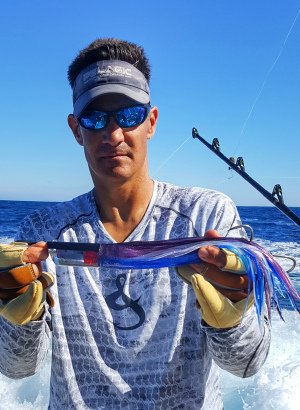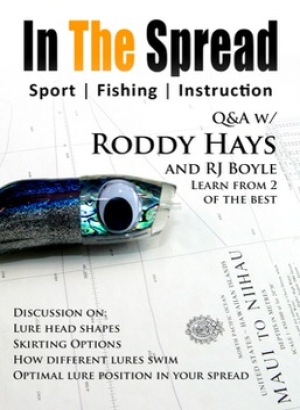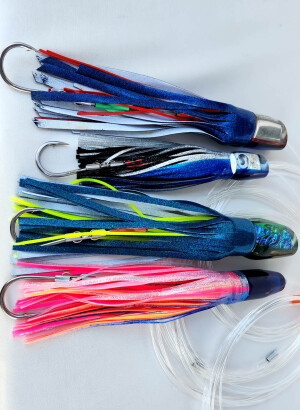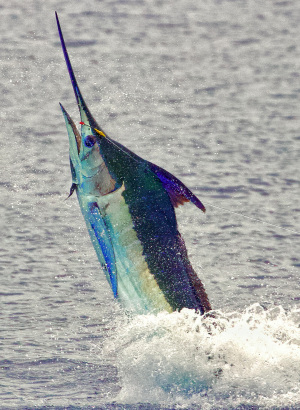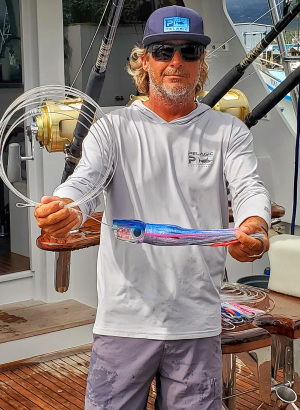Blue marlin fishing is a thrilling sport for sport fishers, with Atlantic and Pacific blue marlin being two of the most coveted gamefish. Techniques include trolling, bait and switch, and live baiting. Trolling involves dragging lures behind a boat at different depths and speeds, while bait and switch uses live baitfish to attract the marlin's attention. In The Spread, a sport fishing educational video company, offers valuable information on rigging lures and trolling techniques.
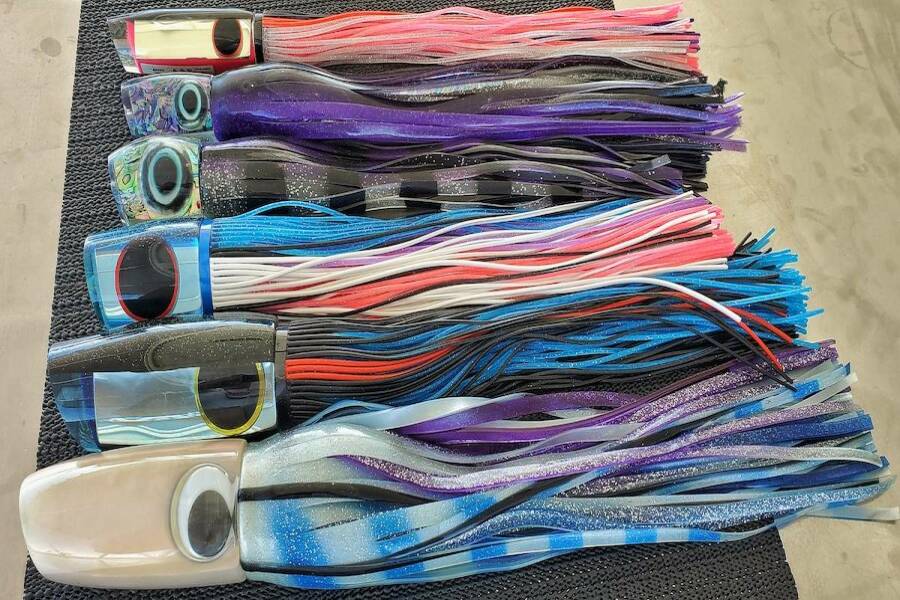
Blue Marlin – Offshore Fishing and Lure Rigging
Blue marlin fishing
Few things are as thrilling to a sport fisherman as the challenge of hooking and landing a blue marlin. The Atlantic and Pacific blue marlin are two of the most coveted gamefish in the world, and they can be found in warm waters around the globe. Blue marlin are notorious for their power and speed, making them a formidable opponent for any angler. But, with the right technique and equipment, you can increase your chances of success.
Overview of In The Spread
As a sport fishing educational video company, In The Spread is dedicated to helping fishermen improve their skills and catch more fish. Our team works exclusively with the very best fishermen in the world to produce high-quality instructional videos that cover everything from rigging lures to trolling techniques. We believe that sharing knowledge and experience is the key to becoming a better angler, and we're proud to offer our subscribers access to some of the most valuable fishing information available. To learn more about rigging marlin lures for offshore fishing and kick your fishing up to the next level, visit our Saltwater Fishing Lures video library.
Overview of the Different Techniques Used in Blue Marlin Fishing
- Trolling: Trolling is one of the most popular techniques used to catch blue marlin. It involves dragging a variety of lures or bait behind a moving boat at various depths and speeds. This technique can be used in both deep and shallow waters, and the type of lure and the speed of the boat will vary depending on the conditions and the fish's behavior.
- Bait and switch: Another popular technique used to catch blue marlin is bait and switch. This involves using a live baitfish, such as a bonito or mackerel, as bait. The baitfish is cast out and left to swim freely while the boat is maneuvered to draw the attention of the blue marlin. Once the marlin is spotted, the baitfish is quickly reeled in and replaced with a lure that mimics the live baitfish's action.
- Live baiting: Live baiting is a technique that involves using live baitfish to entice blue marlin to strike. The live baitfish is usually rigged with a circle hook and dropped to a desired depth. The boat is then slowly maneuvered to attract the attention of the blue marlin. When the marlin takes the bait, the angler waits for the fish to swallow the bait before setting the hook. Live baiting is an effective technique when the blue marlin are not responding to lures or bait and switch.
Knowledge is the Best Tool
The elusive blue marlin, known for its strength, captivates the hearts of anglers around the world. Successful blue marlin fishing requires an understanding of the best time and place, as well as employing effective strategies.
- Best Time and Place to Fish for Blue Marlin:
- Geographical Diversity: Blue marlin are not confined to a single locale; they inhabit various oceans and seas globally. In the Atlantic, they are commonly found in the Gulf of Mexico, the Caribbean, Madeira, Cape Verde, the Azores, and along the East Coast of the United States. Meanwhile, in the Pacific, prime spots include Hawaii, Mexico, Fiji, and Costa Rica. Each of these regions offers a unique experience, with different challenges and rewards.
- Seasonal Variation: The best time to fish for blue marlin typically aligns with the summer months when ocean temperatures rise, and these majestic creatures become more active. During summer, they tend to migrate closer to the surface in pursuit of prey. However, it's worth noting that blue marlin can be encountered year-round in some areas, such as the tropical waters of Hawaii. Local knowledge is invaluable for pinpointing the optimal months within each region.
- Tips and Tricks for Blue Marlin Fishing:
- High-Quality Gear: A fundamental aspect of successful blue marlin fishing is investing in high-quality gear. Sturdy rods and reels are essential, as these fish can grow to immense sizes and put up a formidable fight. Durable lines with appropriate pound-test ratings are crucial to withstand their power.
- Varied Lures: Blue marlin are known for their preference for specific baitfish at different times and locations. To maximize your chances of hooking one, carry an assortment of lures, including artificial and natural baits. Experiment with various colors, sizes, and shapes to mimic the local prey species. Having a selection of lures allows you to adapt to changing conditions and the marlin's feeding preferences.
- Weather and Water Conditions:
- Paying close attention to the weather and water conditions is vital. Blue marlin are sensitive to temperature variations, currents, and water clarity. Warm water is typically more conducive to their presence, but they can also be found near temperature breaks and upwellings where prey congregates. Studying weather patterns and oceanographic charts can help you identify promising areas and times to fish.
- Trolling Techniques:
- Trolling is a popular method for blue marlin fishing. It involves dragging lures or baited lines behind a moving boat. Effective trolling involves varying the speed, depth, and pattern to mimic the natural movement of prey. Pay attention to bird activity, as seabirds often hover around feeding marlin, providing clues about their whereabouts.
- Live Bait:
- In some locations, such as Hawaii, live baiting is a preferred technique. Using live baitfish like skipjack tuna or small bonito can entice blue marlin with the realism and movement of natural prey. Rigging live bait properly and keeping it lively is key to attracting these apex predators.
In conclusion, pursuing the elusive blue marlin requires a combination of knowledge, preparation, and adaptability. The best time and place to catch them may vary, but with the right gear and strategies, the thrill of landing one of these magnificent creatures becomes an achievable dream for dedicated anglers.
How to Rig Marlin Trolling Lures
- Rigging a blue marlin lure: When it comes to blue marlin fishing, the right rigging can make all the difference. Properly rigged lures are key to enticing these elusive predators to strike. To begin with, you'll need a sturdy leader, strong enough to withstand the power and speed of the blue marlin. From there, you'll want to rig a lure that mimics the movement and appearance of the blue marlin's natural prey.
- Explanation of stiff rigging: A stiff hook rig is a type of rigging used for trolling lures when targeting large game fish such as blue marlin. This rig allows the hook to remain in a more upright position when trolled through the water, making it easier for the hook to penetrate the fish's mouth when it strikes the lure. When rigging a stiff hook, it's important to position the hook in the correct orientation on the lure so that it sits upright in the water. This can take some trial and error, as different lures and hooks may require slightly different rigging methods. Some anglers prefer to use wire leader with their stiff hook rigs, while others opt for fluorocarbon or monofilament leader depending on the fishing conditions and the behavior of the fish they are targeting.
- Single hook vs Double hook rigs: A single hook rig for marlin fishing consists of a single hook attached to a leader that is connected to the main fishing line. The hook is designed to be large and strong enough to hold a large marlin. A double hook rig, on the other hand, has two hooks attached to the leader, one behind the other. The main benefit of a single hook rig is that it reduces the chances of a marlin throwing the hook during the fight, as there is only one point of contact. Single hooks also cause less damage to the marlin, making it easier to release the fish alive. However, the downside of a single hook rig is that it can be more difficult to hook the marlin in the first place, as the hook has to be precisely positioned in the fish's mouth. Double hook rigs, on the other hand, increase the chances of hooking a marlin, as there are two hooks to potentially catch in the fish's mouth. This makes it easier to set the hook and keep the fish on the line during the fight. However, double hook rigs can cause more damage to the marlin, which can reduce the chances of successfully releasing the fish alive.
In summary, the choice between a single hook and double hook rig for marlin fishing depends on the angler's preference and fishing style. A single hook rig may be better for catch and release fishing, while a double hook rig may be better for anglers who prioritize hooking and landing the fish.
The Importance of the Lure Spread
Blue marlin fishing requires a deep understanding of the elusive and powerful blue marlin's behavior and preferences. Among the many techniques and strategies employed, one key factor that significantly contributes to success is the strategic placement of lures in the water. This aspect of the sport is often overlooked by beginners but holds immense importance for those looking to increase their chances of landing the prized blue marlin.
The art of luring blue marlins involves more than just casting a few lines into the water and hoping for the best. Instead, it demands careful planning, knowledge of the marlin's habits, and the use of specialized lures and terminal connections. Here's an exploration of why lure placement is pivotal in successful blue marlin fishing:
- Mimicking Natural Prey: Blues are apex predators in the ocean, and their predatory instincts are finely tuned. To entice these majestic creatures, anglers must present their lures in a manner that closely resembles the natural prey items of blue marlin. The strategic placement of lures at varying distances from the boat replicates the appearance of a school of smaller fish swimming, which can attract the attention of a marlin looking for an easy meal.
- Covering More Ground: Blue marlin are known for their remarkable speed and agility. By spreading out lures at different distances and depths, anglers can effectively cover more water and increase their chances of encountering a marlin. This approach maximizes the visibility of the lures and presents them in different zones within the water column, increasing the likelihood of a marlin encountering one of the baits.
- Minimizing Competition: Marlin can be territorial and competitive, especially when it comes to feeding. By strategically placing lures at varying distances, you can create an illusion of multiple opportunities for the marlin to strike. This can reduce the chance of one marlin being spooked by the presence of another near the boat, as they might be too focused on individual lures to notice the others.
- The Element of Surprise: Blue marlin are known for their intelligence and the ability to distinguish between real prey and artificial lures. By spreading out lures at different distances, you can increase the element of surprise, making it more difficult for the marlin to discern the artificial nature of the baits until it's too late, resulting in a successful hook-up.
In the pursuit of mastering blue marlin fishing, resources like "In The Spread Fishing Videos" offer invaluable guidance. They provide a wealth of knowledge through videos and tutorials, teaching anglers the art of rigging marlin fishing lures and mastering terminal connections. This kind of specialized instruction equips anglers with the skills and techniques needed to optimize lure placement, increasing their chances of successfully hooking and ultimately landing a blue marlin.
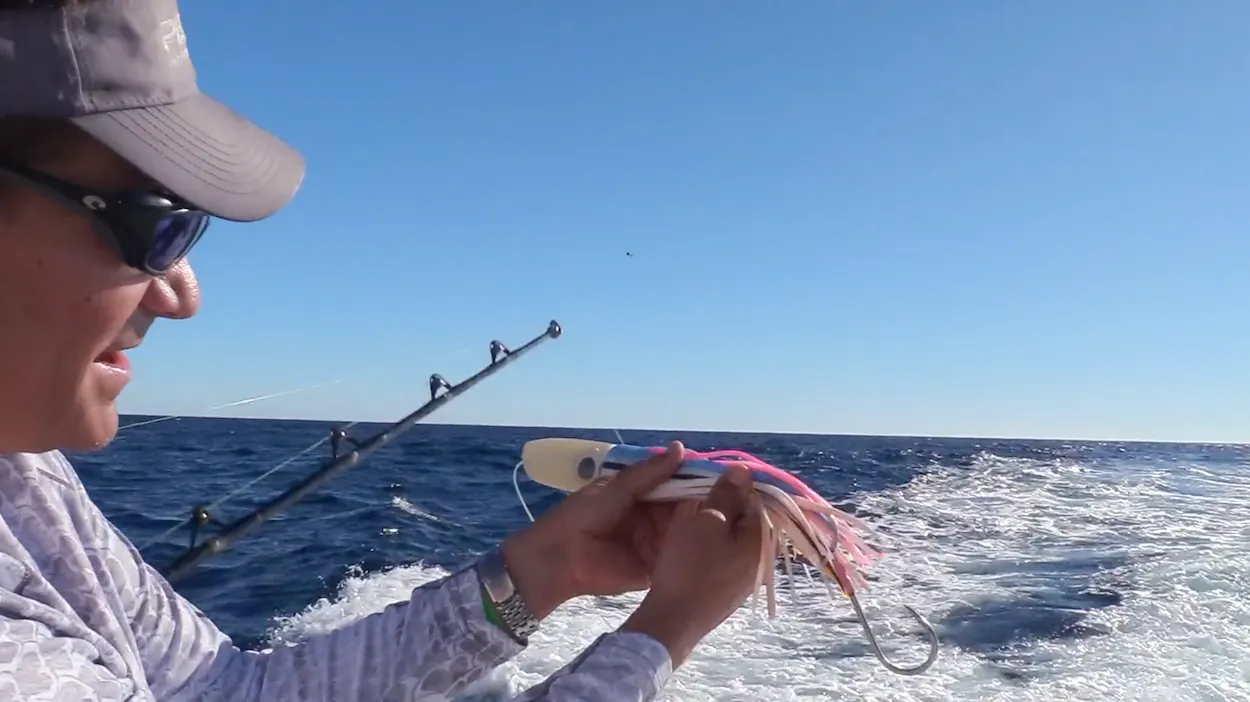
Trolling for Blue Marlin
Trolling for blue marlin is a demanding fishing technique that offers anglers the chance to engage with one of the ocean's premier apex predators. Blue marlin fishing combines skill, strategy, and a deep appreciation for the open sea, making it an unforgettable experience for those who embark on this adventure.
To truly appreciate the excitement and effectiveness of trolling for blue marlin, it's essential to delve into the intricacies of this fishing approach:
Overview of Trolling
Trolling for blue marlin involves using a variety of lures and bait to mimic the fish's natural prey. Skirted trolling lures, like those made by Andy Moyes, Black Bart, and Marlin Magic, are some of the most popular types of lures used for blue marlin fishing. These lures come in a variety of colors and sizes, and are designed to imitate various types of baitfish, squid, and other prey. See our popular video with Andy Moyes, where he discusses head shapes and wave placement Blue Marlin Trolling Lures With Andy Moyes.
The Trolling Setup
To optimize your chances of hooking a blues, it's crucial to optimize your lure presentation. This typically involves creating a carefully curated "lure spread" that is designed to entice blue marlin effectively.
- Variety in Lure Selection: A successful trolling setup for blue marlin starts with a diverse array of lures. Blue marlin can be picky eaters, and they are known to be attracted to different types of prey at various times. Therefore, having a selection of lures with different shapes, colors, and actions is key. This variety helps mimic the natural baitfish and prey in the marlin's diet.
- Differing Sizes and Colors: Blue marlin have distinct preferences when it comes to lure size and color. Some days they may be more inclined to strike larger, more conspicuous lures, while on other days, they might be attracted to smaller, subtler presentations. By incorporating a range of lure sizes and colors into your spread, you can adapt to the marlin's changing mood and preferences.
- Lure Placement: The key to a successful trolling setup lies in the placement of your lures. By setting them at different distances from the boat, you create a dynamic "lure spread" that covers a wide area of water. This is essential because blue marlin are known to roam large territories in search of prey. Having lures at varying distances increases your chances of intercepting these magnificent fish.
- Using Teasers: In addition to your primary lures, it's common to incorporate teaser baits into your trolling spread. Teasers are smaller, eye-catching lures or daisy chains that are positioned in front of your main lures. They create additional attraction and commotion in the water, helping to pique the curiosity of nearby marlin.
- Lure Presentation: The way your lures move through the water is crucial. Some lures are designed to create a splash or a trail of bubbles, while others have a more subtle, swimming action. Experimenting with different lure actions and adjusting your trolling speed can be key to triggering a marlin's predatory instincts.
- Trolling Speed: The speed at which you troll can also affect the effectiveness of your setup. Blue marlin have different preferences for trolling speeds, so it's essential to vary your boat's speed to find the sweet spot that entices them to strike.
- Timing and Location: Lastly, successful trolling for blue marlin often involves understanding the local conditions, including water temperature, current patterns, and known feeding areas. Timing your trolling efforts to coincide with the marlin's feeding habits and being in the right location can significantly improve your chances of success.
Setting up the best trolling spread for blue marlin is a combination of art and science. By carefully selecting a variety of lures, positioning them at different distances, and paying attention to the fish's behavior and preferences, you can create a tantalizing presentation that increases your odds of hooking these magnificent creatures while enjoying the thrill of sportfishing.
Speed and Positions
Finding the optimal trolling speed and lure spread for blue marlin fishing is a delicate balance that requires a deep understanding of the dynamic and ever-changing marine environment. Several factors come into play when determining the most effective trolling strategy to maximize your chances of hooking a prized blue marlin.
- Sea Conditions: The first and foremost consideration is the sea conditions. Blue marlin are known to prefer certain water temperatures and currents, so it's essential to adapt your trolling speed and spread accordingly. In calm seas with a stable temperature gradient, you might find that a consistent speed of 8-10 knots works well. However, if the seas are rough or if you're in an area with fluctuating currents, you may need to adjust your speed to keep the lures at the desired depth and position.
- Clean Water Alleys: Clean water alleys are areas behind your boat where the water is less turbulent, allowing the lures to swim more naturally and attract the attention of blue marlin. Identifying these alleys and adjusting your trolling pattern to pass through them can significantly increase your chances of success. In some cases, you might need to slow down or speed up to ensure your lures stay within these productive zones.
- Lure Selection: The size and type of lures you choose play a crucial role in your trolling spread. Larger lures are placed closer to the boat. Smaller lures, on the other hand, can be positioned further back in the spread to target any blue marlin that may be trailing the main attraction. It's essential to experiment with different combinations of lure sizes, colors, and styles to see what the blue marlin in your area are most responsive to.
- Observation and Adaptation: Successful blue marlin fishing often requires keen observation and adaptability. Keep an eye on your sonar and watch for signs of baitfish or marlin activity in the area. If you notice changes in the environment or the behavior of the fish, be ready to adjust your trolling speed and spread accordingly. This flexibility can make all the difference in hooking that elusive blue marlin.
The optimal trolling speed and spread is not a one-size-fits-all approach. It involves a combination of factors, including sea conditions, clean water alleys, lure selection, depth control, and adaptability. Successful anglers continuously refine their techniques and remain attentive to the ever-changing conditions of the open ocean, increasing their chances of encountering and successfully hooking these majestic and powerful fish.
Tips on Trolling
Trolling requires a combination of skill, patience, and adaptability. To have a successful and enjoyable fishing experience, there are several key aspects to consider.
First and foremost, keeping a close eye on the lures is paramount. Blue marlin are known for their incredible speed and power, and they can strike suddenly and aggressively. Ensuring that your lures are running smoothly and simulating the appearance of prey is crucial. Observing them closely allows you to detect any irregularities, such as fouled hooks or tangled lines, and promptly address them to maintain an effective presentation.
In the heat of the moment, when a blue strikes, quick reactions are essential. These fish can deliver powerful, blistering runs, and if there is any slack in the line, they can easily throw the hook. Therefore, it is vital to be ready to reel in any slack immediately upon sensing a strike. Proper technique and coordination with your fellow anglers can make all the difference in successfully hooking and landing a blue marlin.
Another important aspect of trolling is adaptability. Fishing conditions can change from day to day and even throughout the day, including factors such as water temperature, current, and the presence of baitfish. Experimenting with trolling speed and lure spread allows you to fine-tune your approach to match the current conditions. Sometimes, blue marlin may be more active and responsive to faster trolling speeds, while other times, a slower and more methodical approach may be necessary to entice them.
To gain a deeper understanding and improve your trolling skills for blue marlin, there are educational resources available, such as the videos provided by "In The Spread." These instructional videos offer valuable insights and detailed instructions on various aspects of trolling for blue marlin, including lure selection, rigging techniques, and effective strategies for different scenarios. Learning from experts through these videos can enhance your knowledge and increase your chances of a successful catch.
Trolling for blue marlin is a captivating endeavor that requires constant vigilance, quick reflexes, and adaptability to changing conditions. By keeping a close eye on your lures, being prepared for swift strikes, and adjusting your trolling approach as needed, you can increase your chances of hooking and landing these magnificent fish. Educational resources like the videos from "In The Spread" can serve as valuable tools to hone your skills and elevate your blue marlin trolling game.
Quality Lures Make All the Difference
Blue marlin fishing requires the use of high-quality lures to attract the fish to the bait. When it comes to marlin lures, there are countless options to choose from, each with its own benefits and drawbacks.
One of the most popular types of marlin lures is the skirted trolling lure, which is designed to imitate the movements of a baitfish in the water. These lures come in various sizes and shapes, and are typically rigged with a hook in the back of the skirt to make it look like a natural fish swimming through the water.
When it comes to lure head shapes, there are various options to choose from, including bullet, concave, and cupped. Each shape has its own unique swimming action, and the choice often comes down to personal preference and the specific conditions of the fishing location.
Some of the top marlin lures on the market include the Moldcraft Wide Range, Joe Yee Super Plunger, Black Bart Hot Breakfast, Andy Moyes J Boy and Marlin Magic “The Hibby”. These lures have proven track records of attracting and hooking blue marlin, and are favored by many experienced fishermen.
Overall, choosing the right marlin lure comes down to understanding the fish's behavior and the conditions of the fishing location. By experimenting with different types of lures and techniques, fishermen can increase their chances of success in catching blue marlin.
As we come to the end of this article, we hope that you have gained valuable insights into blue marlin fishing. From understanding the different techniques used to catch blue marlin to rigging the perfect trolling lure and choosing the right tackle, we have covered a lot of ground.
Remember, blue marlin fishing can be challenging, but it is also one of the most rewarding experiences for any angler. And if you want to learn more about blue marlin fishing and other types of fishing, be sure to check out In The Spread. Their online courses and videos provide invaluable information for anglers of all levels.
So, gear up, hit the water, and get ready to catch the fish of a lifetime!


